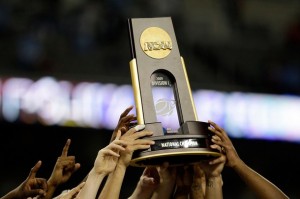In Part I we took a look at the differences and similarities of National Champions over the last 13 years. We discovered over this time there have been numerous schools, coaches, styles, tempos, and experience levels in the makeup of a National Champion. We also discovered using tempo free statistical data the majority of them have 2 things in common, strong offenses and even stronger defenses. In Part II we broke down the NCAAT by the round to determine if there is a clear statistical difference between teams who lose in each of the rounds. While it came as no shock to anyone to learn good (and even great) teams can blow it by losing early there is a distinction between most of the rounds. Using this information we can move on now to Part III where first we will briefly discuss the usage of this tool as a possible predictor for filling out your brackets (Ken Pomeroy even says his tempo free stats are a tool for predicting games) and secondly use it to evaluate coaches, starting with our own Mark Gottfried, to determine if they under or over achieve during the NCAAT and what kind of teams and expectations we should come to expect from him/them over the course of their tenure.
Prediction through Probability
Let’s start by plotting the ODS trends by round to get a visualization of what we have and overlay the 2015 version of the Wolfpack to see where it falls across each of the rounds. Note: Round 1 = Round of 64 and Round 7 = National Champion.
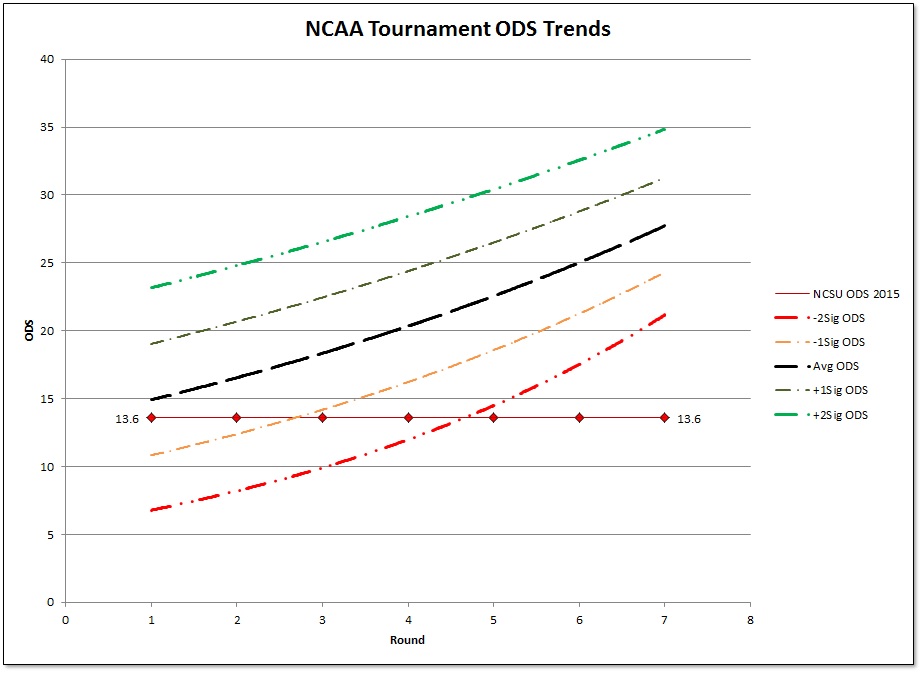
If you recall in Part II I laid out how the -1Sigma line delineates between the upper 84% and the bottom 16% of teams that lost in each round and thus who should have a legitimate chance at qualifying for the round. If we look at the current ODS value of the Wolfpack heading into the 2015 NCAAT we see they are near the bottom of the 84% who will make the Round of 32 and then less likely to make it to the second weekend. Here are the ODS, AOE, & ADE values of the sigmas for each round.
Breaking the ODS into the Adjusted Offensive Efficiency (AOE) and Adjusted Defensive Efficiency (ADE) we can plot the 2015 Wolfpack to see how we’ll they are expected in each phase. Looking at the AOE we see the Pack have at least a Final Four (FF) caliber offense but when you look at the Pack’s ADE we see what is truly holding them back to the first weekend. I’m attaching the table of MG’s teams showing the 3 values and breaking down the defense into the Four Factors and final results.
Next I calculated the probability of reaching each round by ODS values. If we plot the 2015 Wolfpack we can see they have about a 74% chance of reaching the Round of 32 and a 44% chance of reaching the Sweet 16. After that the percentages are so low it’s not even worth mentioning.
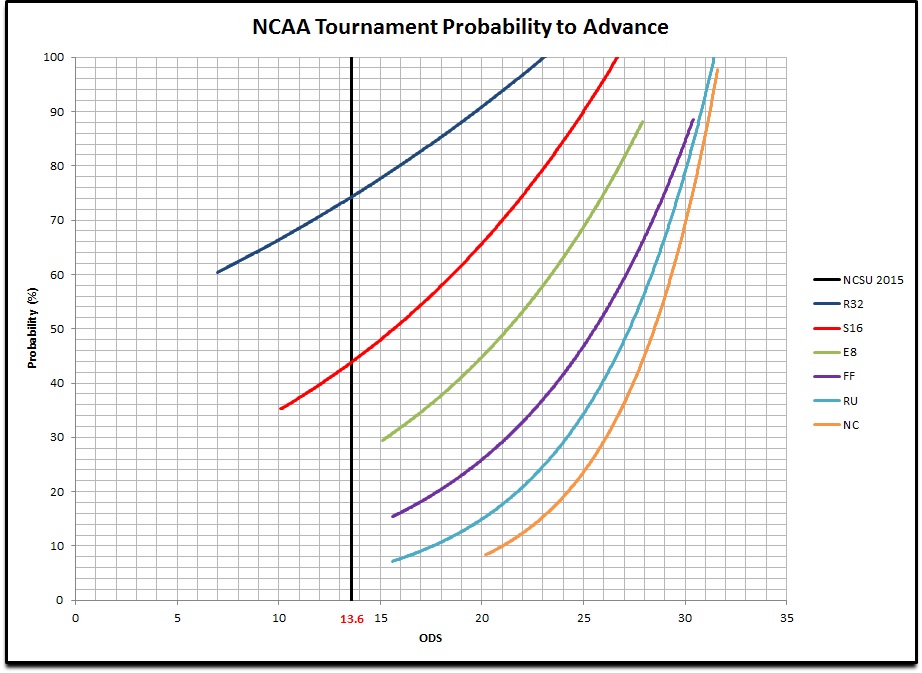
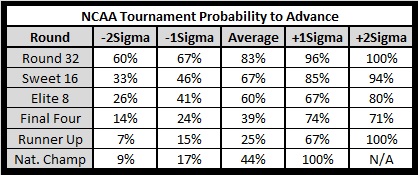
I believe this can be a useful tool in helping you decide just how far into the NCAAT you might want to place teams.
Mark Gottfried
Now let’s start looking at our own coach, Mark Gottfried (MG), and try and get an idea of how he’s done over the last 13 years. I will be using the final ODS values for these bell curve graphs to see how his teams ended the season in relation to the rest of the population. If we overlay MG teams with the Round of 32 (R32) we can see they are right in the 68% population (+/-1Sig) of teams who make the R32. This tells us that he produces clear R32 teams every year he’s been in the tournament.
Looking at MG in comparison to the Second Weekend teams we see about 50/50 playing into the bottom of the S16 while only a blip to the bottom of the E8. Lastly we see MG just hasn’t played up to the level of the Final Four or beyond.
Let’s look at this in a table format on a round by round basis to see how he has done in relation to how his teams have entered the NCAAT.
NOTE: These ODS values are Pre-NCAAT so we get an idea of predicting how he should have done and what he really did.


Let me try and explain what we’re looking at in case my legend is unclear:
MG has been coaching for 11 of the last 13 seasons; he has been to the NCAAT 8 of those 11 years for an appearance of 73%. Of those 8 NCAAT appearances he has had 4 teams reach the Round of 32 equaling 50%. When entering the NCAAT his teams had an ODS value of at least -1Sigma for the R32 a total of 6 times and of those 6 teams only 3 of them made it to the R32 for 50%.
As you can see most of his teams are first weekend teams and as such have performed that way. He has entered the NCAAT with 1 team capable of making the FF but did not reach it. So how much has he under or overachieved in the NCAAT?
If you have a team predicted to make Round X and you lose at least 2 rounds prior to the predicted round then you have underachieved. The exception being the Runner Up and losing in the E8, there is minimal separation between the 2 rounds. For example, you team is predicted to make the S16 and you lose in the R64 then you underachieved.
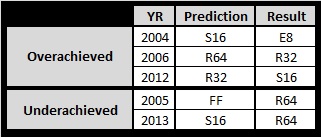
We can easily when times MG has under and overachieved and both have been at Alabama and NC State. While he hasn’t overachieved much, simply making it 1 round beyond prediction, he has bombed pretty badly twice.
How does Mark Gottfried compare to other coaches?
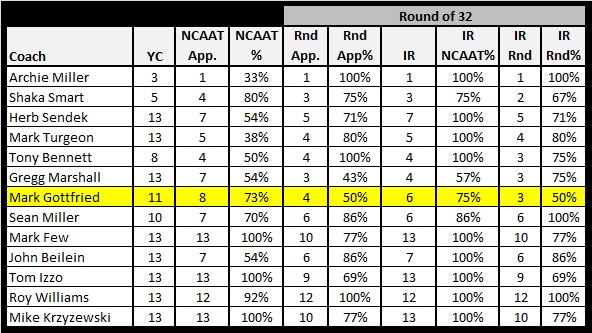
Looking at the Round of 32 we see while MG passable percentage of teams going in as R32 capable he falls short in getting those teams to the R32 as compared to a list of coaches who are early, similar, and long in their careers as coaches.
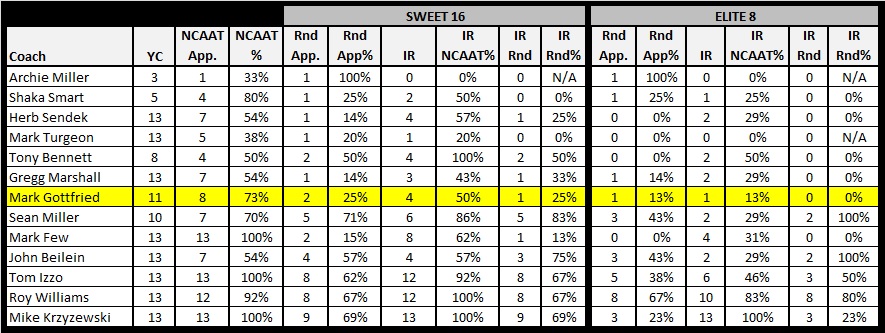
As you can see most coaches percentages are dropping as we go further into the rounds but the questions remain, how is he doing in comparison to others and again he is lagging behind. I do want to point out a couple of other coaches: Mark Few has shown over the years he is a good regular season coach but gets an F in the NCAAT; also Sean Miller consistently meets the expectations that is expected of him time and time again with the teams he has created when entering the tournament and does it at a second weekend level.
Before we look at the National Champions I want to point out a couple of things about the FF and RU: Can anyone believe that Sendek has created 2 Runner Up teams during his time? I was floored. Also just look at K’s numbers and has anyone done less with more than he has over the last 13 years?
Finally the National Champions.
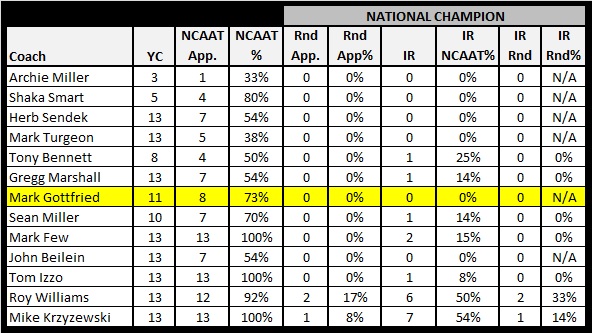
As we can see there are a handful of coaches who have created the teams capable but 2 on this list stand out as consistently doing it and that’s Roy and K. I wonder how long until the landscape will change.
SUMMARY
I’ve laid out a few tools that I hope can be helpful to others in filling out their brackets and helping to evaluate coaches, including Mark Gottfried. Gottfried has shown over the years to be a first weekend NCAAT coach. His teams come in with good offenses but usually lack in defense which is a big contributor to his teams entering the NCAAT as first weekend teams. I do believe the data backs up this assertion. If Gottfried wants to go further, If NC STATE wants to go further under MG, then he has to do a better job than he has shown because at this moment he’s not even setting up his teams to catch lightning in a bottle to make deep runs.


